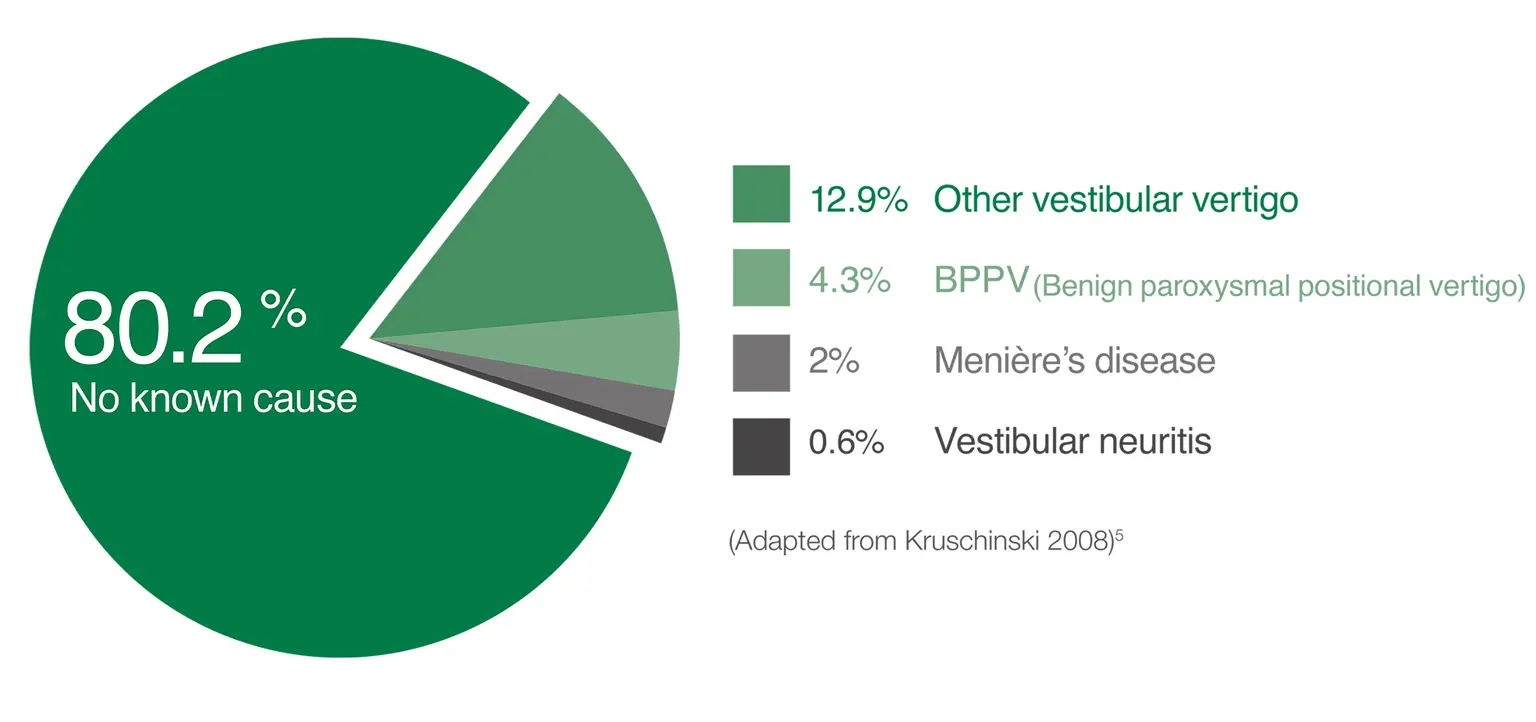
Vertigo – When everything starts to turn
Vertigo, also known as dizziness, is a sensation of feeling off balance. The most common type is peripheral vertigo. A problem in the inner ear, which controls the balance, causes most cases of vertigo. It's a widespread problem that affects almost one-third of people over 60 years of age.¹ It can severely impair daily life and result in high suffering for those affected.
What types of vertigo are there?
The type of vertigo is a crucial hint where to look for the causes. Therefore, it is essential to identify the type of vertigo as a first step. Types of vertigo to which patients attribute a direction often have a definite cause, e.g., damage to the balance organ in the inner ear (peripheral and vestibular disorder). As diverse as the causes of vertigo might be, the different types of vertigo or dizziness are just as varied. There's dizziness with a floating sensation which is a sinking feeling, and postural vertigo that results in a shaky, uncertain stand and gait.
Rotational vertigo
The so-called rotational vertigo is among the most common. It often comes with a spinning sensation, as if the room is turning or tilting – similar to riding a merry-go-round. Rotational vertigo attacks occur spontaneously, are unpredictable, and can last from a few minutes to several days. This vertigo type falls into two sub-types: the rotational vertigo attack and the persistent rotational vertigo.
Persistent rotational vertigo
This type of vertigo shows persisting symptoms for hours or even days. Typically, this goes along with a tendency to fall, nausea, vomiting, and eye tremors, called nystagmus. The causes of this kind of vertigo are, in most cases, linked to a functional disorder of the balance system. For example, rotational vertigo is often the result of an inflamed balance nerve shutting down the balance system on one side. Usually, the complaints subside after about one to two weeks. In rare cases, damage to the central structures of the brain can also result in persistent rotational vertigo. Causes can be very diverse, ranging from blood circulatory problems, brain tumors to neurological failure in the brain.
Rotational vertigo attacks
Typically, attacks of rotational vertigo set in very suddenly and severely and can last from seconds to several minutes. People affected report experiencing nausea, a spinning sensation, and a tendency to fall. The cause of such attacks of rotational vertigo can often be Manière's disease. Still, the so-called benign paroxysmal positional vertigo is also known for its sudden attacks that only last for a few seconds and disappear quickly.

Postural vertigo
Postural vertigo manifests in an uncertain, shaky gait as if the room is staggering. Similar to rotational vertigo and floating sensation (vertigo), it is another unpleasant way of experiencing vertigo. Postural vertigo includes being unsteady on the feet and having a tendency to fall. The so-called somatoform vertigo typically induces postural vertigo, making it a type of emotional vertigo. Triggers can be depression, anxiety, stress, or even large crowds or the fear of flying. Usually, it is accompanied by nausea, shortness of breath, rapid heartbeat, or sleeping disorders. Phobias and anxiety disorders often accompany shaking, while headaches often accompany depression. Postural vertigo attacks usually subside after a few seconds. In individual cases, however, they can become a constant companion. For those affected, it is vital to learn how to manage staggering vertigo: In the long run, patients should consider psychotherapy.
Floating sensation (vertigo)
On the other hand, a floating sensation (vertigo) makes you feel like riding an elevator that starts to move: The bottom of the elevator cabin seems to either lift or drop, causing a feeling of up and down dizziness. It can also be indicative of somatoform causes. In contrast to directional forms of vertigo, non-directional vertigo or lightheadedness makes those affected feel wobbly on their legs; they feel "woozy" or have visual problems (seeing double or black spots before their eyes). Many patients report "cotton in their head." Non-directional vertigo can point toward cardiovascular or metabolic diseases and visual disorders as possible causes. Apart from rotational and postural vertigo, floating sensation (vertigo) is considered a particularly unpleasant and annoying type of vertigo. Those suffering from it have the permanent feeling of riding on an elevator or rollercoaster. Typically, floating sensation attacks last from a few seconds up to several minutes and are often accompanied by drowsiness and severe discomfort. There might also be the symptom of an unsteady gait, which increases the danger of falling.

Types of vertigo
The types of vertigo give the doctor important hints where to look for the cause of the complaints.
Vertigo symptoms
Patients with vertigo typically describe it as a feeling like they are spinning, tilting, swaying, unbalanced, or pulled in one direction. Thereby, vertigo symptoms come in many different forms: Some patients tend to fall, others have been feeling dizzy for weeks – some see black spots when standing up. In contrast, others talk about an inexplicable sudden "emptiness in their head" or a spinning sensation. However, they often don't only suffer from vertigo alone but also present with additional symptoms. Specific accompanying symptoms point to certain causes. Therefore, describing the accompanying symptoms is essential for any diagnosis.
Other symptoms that may accompany vertigo include:
- Nausea
- Vomiting
- Migraine headaches
- Abnormal or jerking eye movements (nystagmus)
- Sweating
- Heightened sensitivity to light and noise
- Impaired hearing and ringing (tinnitus) in one ear
- Rapid heartbeat and anxiety attacks
- Problems with talking or swallowing
What causes vertigo?
People suffering from vertigo and dizziness feel as if they lost their sense of orientation in space and they experience motions that do not really exist. This leads to balance problems to the point of falling as well as a range of different symptoms. Vertigo comes in many forms and emerges through different processes.
Possible causes of the development of vertigo/dizziness include2-4:
- Disorders of the vestibular organ of balance in the inner ear
- Diseases of the central nervous system
- Conflicting input from the various senses (disequilibrium)
- Cervical, thoracic, or lumbar/sacral spine diseases interfering with spatial proprioception
- Impaired blood flow
- Mental reactions and disorders
- Toxic environmental or drug exposures
The differential diagnosis of vertigo is based on a targeted evaluation by type, attack duration, triggers, and associated symptoms, a vestibular and neurological examination, and knowledge of the most common vertigo syndromes.

Vertigo is often caused by an inner ear problem. Some of the most common causes include:
BPPV
Benign paroxysmal positional vertigo (BPPV) occurs when tiny calcium particles are dislodged from their normal location. Typically, BPPV vertigo occurs out of the blue, lasts only a few seconds and ends abruptly. It’s triggered by turning in bed, getting up from a reclined position or bending over quickly. Fortunately, as the name indicates, benign positional vertigo is generally harmless. However, the fact remains that it is unpleasant for those affected. BPPV can occur for no known reason and may be associated with age.
Meniere's disease
This is an inner ear disorder thought to be caused by a buildup of fluid and changing pressure in the ear. It can cause episodes of vertigo along with ringing in the ears (tinnitus) and hearing loss.
Vestibular neuritis or labyrinthitis
This is an inner ear problem usually related to infection (usually viral). The infection causes inflammation in the inner ear around nerves that are important for helping the body sense balance.
Not only can certain movements or situations trigger vertigo. It can also occur as accompanying symptoms of various other diseases. Therefore, it is always important to discuss vertigo symptoms with a physician.

How to treat vertigo?
There are many different types of vertigo treatment. True-and-tested methods of any vertigo therapy are exercises, changing lifestyle and medication. In general, it is important to discuss symptoms with a doctor, who will determine an individual and specific treatment plan. In cases where the symptoms are the result of an underlying disease, such as blood circulatory problems, the doctor treats the organic causes first. With chronic vertigo and some types of stress vertigo, special physiotherapeutic exercises can help boost the entire balance system.
The brain structures have the ability to counteract vertigo (central-vestibular compensation). To do so, the brain has to learn to consider only correct information and ignore erroneous one – e.g. information coming from an affected balance organ. Even the malfunctioning of one or both balance organs can be compensated by way of consistent and strict balance training. Balance exercises can help this learning process. Even the movements of daily life, e.g. taking a walk, can be a helpful balance exercise.
The balance system and brain need oxygen and nutrients to work properly. Outdoor activities are among the most important self-help steps with vertigo. Healthy food is a crucial contribution as well: In individual cases such as Menière’s disease, a diet low in sodium can be helpful in lowering blood pressure and thus alleviate symptoms. Caffeine and its stimulating effect on the central-nervous system might also have a positive impact on vertigo – so there is no objection to drinking coffee, but in moderation.
Pharmacological approach
Conventional treatments for vertigo include chemical-synthetic medications such as dimenhydrinate and betahistine. Both show a relevant reduction in the mean of frequency, duration, and intensity of the vertigo attacks. They are used to treat symptoms such as dizziness, ringing in the ears, loss of hearing, and nausea. However, even though the effectiveness of these medications are proven, they often come with side effects. Drowsiness, headache, dry mouth, nausea and even more serious side effects such as fast, pounding, or irregular heartbeat are possible. Additionally, many chemical-synthetic medications dampen the central nervous system, which can lead to drowsiness and can reduce the central compensation mechanism.6-9
Natural medicine approach
In the context of vertigo treatment with medication, natural pharmaceutical products have a crucial advantage over other medications such as betahistine or dimenhydrinate, since no side effects or interactions are known. Therefore, alternative medical practices are common in the treatment of vertigo. Ginkgo biloba extract is is used for improving the oxygen supply of the balance system. But also natural ingredients such as Indian berry (Anamirta cocculus), spotted hemlock (Conium maculatum), amber (Ambra grisea), and rock oil (Petroleum rectificatum) have been known to be effective medicines for vertigo, motion sickness, and nausea for a long time. It is also important to know that synthetic compounds with sedative effect should only be taken for a few days or weeks. In contrast, most natural medicines have a very good safety profile and can be taken over a long period of time without any problems. However, the efficacy has been shown to be equivalent to that of conventional treatments.6-7,10
Heel natural medicines
1. Fernandez, L., Breinbauer, H.A. & Delano, P.H., 2015. Vertigo and dizziness in the elderly. Frontiers in Neurology, 6(JUN), 1-6.
2. Lempert, T., 2005. Schwindelattacken: Differenzialdiagnose und Therapie. Fortschritte der Neurologie Psychiatrie, 73(10), 605–620.
3. Abholz, H.-H., 2007. Schwindel – Diagnostik und Therapie. ZFA - Zeitschrift für Allgemeinmedizin, 83(9), 373–386.
4. Antonini-Revaz, S., Guyot, J. & Stalder, H., 2004. Schwindel. Primary Care,_ 4(45), 899–904.
5. Kruschinski, C. et al., 2008. Frequency of dizziness-related diagnoses and prescriptions in a general practice database. [In German] Zeitschrift für Evidenz, Fortbildung und Qualität im Gesundheitswesen, 102(5), 313–9.
6. Weiser M, Strösser W, Klein P. Homeopathic vs. conventional treatment of vertigo: a randomized double-blind controlled clinical study. Arch Otolaryngol Head Neck Surg 1998; 124(8):879-885.
7. Wolschner U, Strösser W, Weiser, M, Klein P. Treating vertigo − combination remedy therapeutically equivalent to dimenhydrinate: results of a reference-controlled cohort study. Biol Med 2001;30:184-190.
8. https://www.nhs.uk/medicines/betahistine/
9. https://www.webmd.com/drugs/2/drug-8645/dimenhydrinate-oral/details
10. Issing W, Klein P, Weiser M. The homeopathic preparation Vertigoheel versus Ginkgo biloba in the treatment of vertigo in an elderly population: a double-blinded, randomized, controlled clinical trial. J Altern Complement Med 2005;11(1):155-160.
12. https://www.hopkinsmedicine.org/neurology_neurosurgery/centers_clinics/vestibular/dizzy-now.html
13. https://www.hopkinsmedicine.org/health/conditions-and-diseases/menieres-disease
14. https://www.mayoclinic.org/diseases-conditions/vertigo/symptoms-causes/syc-20370055
15. https://www.webmd.com/brain/types-of-vertigo#091e9c5e80fecd36-3-9


